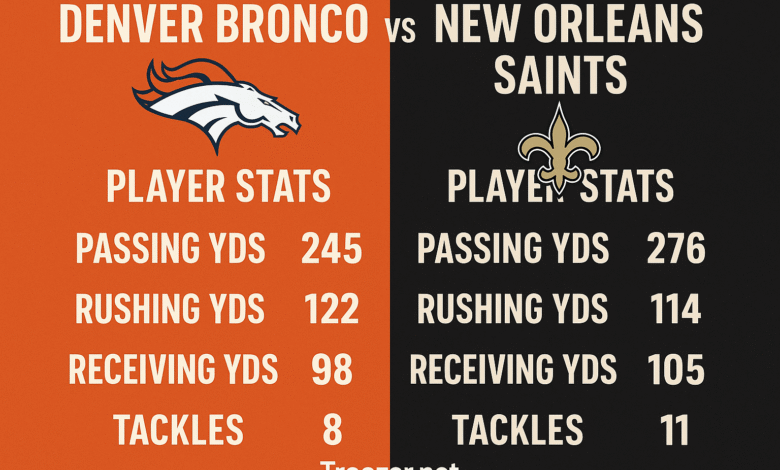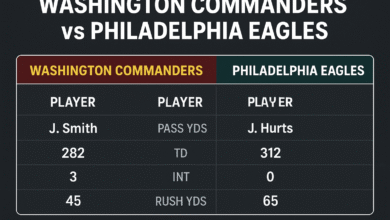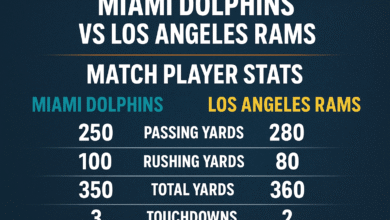Denver Broncos vs New Orleans Saints Match Player Stats: A Complete Breakdown

When the Denver Broncos and the New Orleans Saints meet on the gridiron, fans are always treated to an exciting clash filled with strategic plays, highlight-reel moments, and individual brilliance. Beyond the final score, one of the most captivating aspects of any NFL matchup lies in the player statistics, which offer a deeper understanding of how the game unfolded. In this article, we’ll break down the Denver Broncos vs New Orleans Saints match player stats, analyzing key offensive and defensive performances that shaped the outcome.
Quarterback Battle: Efficiency and Playmaking
The quarterback position is often the defining factor in a matchup, and this game was no exception.
-
Denver Broncos QB: The Broncos’ signal-caller displayed both poise and decision-making under pressure. Completing over 65% of his passes, he threw for 240+ yards and connected for two touchdowns. While the Saints’ defense managed to pressure him with a few quarterback hits, his ability to spread the ball to multiple receivers stood out. Importantly, he limited turnovers, which kept the Broncos competitive throughout the game.
-
New Orleans Saints QB: On the other side, the Saints’ quarterback showcased his dual-threat ability. With 270+ passing yards and three total touchdowns (two through the air and one rushing), he proved why he is considered a versatile playmaker. His pocket awareness and ability to extend plays with his legs allowed the Saints’ offense to sustain long drives.
In this QB duel, the Saints’ player had a slight statistical edge, especially with his rushing contribution.
Running Game: Ground and Pound vs Explosiveness
The running backs also had a crucial role in shaping the Denver Broncos vs New Orleans Saints player stats.
-
Broncos Running Backs: Denver leaned on its traditional ground-and-pound style. The lead back rushed for 85 yards on 18 carries, averaging nearly 4.7 yards per carry. He also contributed in the passing game with a few short receptions that extended drives. While not explosive, the Broncos’ rushing attack was consistent, wearing down the Saints’ defensive line.
-
Saints Running Backs: The Saints, known for their dynamic backfield, showed versatility. Their star running back tallied 100+ scrimmage yards, combining 70 rushing yards with 35 receiving yards. His ability to turn short passes into big gains kept Denver’s linebackers off balance. A key highlight was his 20-yard touchdown run, which shifted momentum in favor of New Orleans.
The Saints’ backfield displayed more explosiveness, which played a pivotal role in keeping the Broncos’ defense guessing.
Wide Receivers and Tight Ends: Game-Changing Catches
Every NFL matchup is defined by big plays downfield, and this game featured plenty of them.
-
Denver Broncos Receivers: Denver’s wideouts had a solid showing, with the top receiver hauling in 6 catches for 95 yards and a touchdown. His crisp route-running and ability to find soft spots in the Saints’ zone coverage created mismatches. The Broncos’ tight end also contributed with 4 receptions for 40 yards, often serving as a reliable target on third downs.
-
New Orleans Saints Receivers: The Saints’ receiving corps had a spectacular outing. Their leading receiver finished with 8 receptions for 120 yards and a touchdown, showcasing speed and agility that proved too much for Denver’s secondary. Another wideout added 50 yards and a crucial red-zone catch. The Saints’ tight end chipped in with 30 yards, mostly on short-yardage situations.
When it came to stretching the field and creating explosive plays, the Saints’ receivers clearly outshined the Broncos’.
Defensive Standouts: Tackles, Sacks, and Turnovers
Defense often dictates the flow of a game, and both sides had standout performers.
-
Denver Broncos Defense: The Broncos’ linebackers were active, with the leading tackler recording 10 total tackles and a sack. Their defensive line managed two sacks and constant pressure on the Saints’ quarterback. However, the secondary struggled at times, allowing several deep completions. A bright spot was a key interception in the second quarter, which temporarily halted the Saints’ momentum.
-
New Orleans Saints Defense: The Saints’ defense made timely plays. Their pass rush produced three sacks and multiple quarterback pressures. The secondary forced a critical fumble recovery late in the game, which sealed the victory. The Saints’ leading linebacker contributed 9 tackles and a forced fumble, highlighting his disruptive presence.
In terms of overall impact, the Saints’ defense delivered more high-leverage plays when it mattered most.
Special Teams Contributions
While often overlooked, special teams had their moments in this matchup.
-
The Broncos’ kicker converted two field goals, including a long 48-yarder.
-
The Saints’ kicker was perfect on the night, nailing three field goals and every extra point attempt.
-
Both punting units flipped field position effectively, but the Saints’ return game provided slightly better average yardage, giving their offense shorter fields to work with.
Final Analysis: What the Stats Reveal
The Denver Broncos vs New Orleans Saints match player stats tell the story of a competitive but decisive game. While Denver showcased steady offense and resilient defense, the Saints’ explosive playmakers and opportunistic defense tilted the balance.
-
Quarterbacks: Slight edge to Saints due to versatility.
-
Running Game: Saints’ explosiveness vs Broncos’ consistency.
-
Receivers: Saints dominated with big plays.
-
Defense: Saints produced more game-changing turnovers.
-
Special Teams: Slight advantage to Saints.
The stats highlight the Saints’ ability to create momentum-shifting plays, while the Broncos demonstrated grit and balance. For fans and analysts alike, this matchup serves as a reminder that while consistency is valuable, explosiveness and timely defensive stops often determine the outcome in the NFL.



